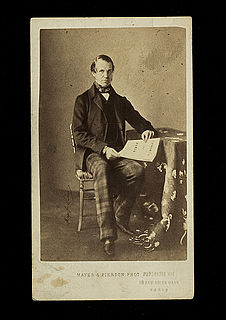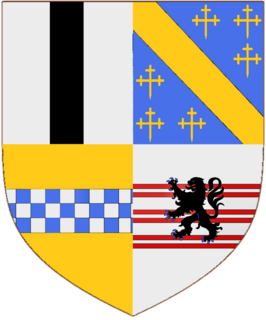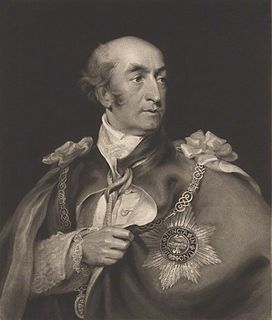
Earl of the County of Cork, usually shortened to Earl of Cork, is a title in the Peerage of Ireland, held in conjunction with the Earldom of Orrery since 1753. It was created in 1620 for the Anglo-Irish politician Richard Boyle, 1st Baron Boyle. He had already been created Lord Boyle, Baron of Youghal, in the County of Cork, in 1616, and was made Viscount of Dungarvan, in the County of Waterford, at the same time he was given the earldom. These titles are also in the Peerage of Ireland.

Earl Ferrers is a title in the Peerage of Great Britain. It was created in 1711 for Robert Shirley, 14th Baron Ferrers of Chartley. The Shirley family descends from George Shirley of Astwell Castle, Northamptonshire. In 1611 he was created a Baronet, of Staunton Harold in the County of Leicester, in the Baronetage of England. He was succeeded by his son Henry, the second Baronet, who married Lady Dorothy Devereux, daughter of Robert Devereux, 2nd Earl of Essex. On the death of her brother Robert Devereux, 3rd Earl of Essex, she became the youngest co-heir to the baronies of Ferrers of Chartley and the barony of Bourchier, which had fallen into abeyance on the death of the third Earl. Shirley was succeeded by his eldest son, the third Baronet. He died unmarried and was succeeded by his younger brother, the fourth Baronet. He was imprisoned in the Tower of London by Cromwell and died there in 1656. On his death the title passed to his eldest son, the fifth Baronet. He died at an early age and was succeeded at birth by his posthumous son, the sixth Baronet.

Earl of Aylesford, in the County of Kent, is a title in the Peerage of Great Britain. It was created in 1714 for the lawyer and politician Heneage Finch, 1st Baron Guernsey. He had already been created Baron Guernsey in the Peerage of England in 1703. Finch was the younger son of Heneage Finch, 1st Earl of Nottingham and the great-grandson of Elizabeth Heneage, 1st Countess of Winchilsea. Lord Aylesford's eldest son, the second Earl, represented Maidstone and Surrey in Parliament. In 1712, he married Mary Fisher, daughter of Sir Clement Fisher, 3rd Baronet. Through this marriage Packington Hall in Warwickshire came into the Finch family. Their son, the third Earl, sat as a Member of Parliament for Leicestershire and Maidstone. His eldest son, the fourth Earl, represented Castle Rising and Maidstone in the House of Commons, and after entering the House of Lords on his father's death, served as Captain of the Yeomen of the Guard from 1783 to 1804 and as Lord Steward of the Household from 1804 to 1812.

Earl of Buckinghamshire is a title in the Peerage of Great Britain. It was created in 1746 for John Hobart, 1st Baron Hobart.

Earl of Guilford is a title that has been created three times in history. The title was created for the first time in the Peerage of England in 1660 for Elizabeth Boyle. She was a daughter of William Feilding, 1st Earl of Denbigh, and the widow of Lewis Boyle, 1st Viscount Boyle of Kinalmeaky. The title was for life only and became extinct on her death in 1667. The title was created for a second time in the Peerage of England in 1674 for John Maitland, 1st Duke of Lauderdale. For more information on this creation, see the article on him as well as the Earl of Lauderdale.

Viscount Hood, of Whitley in the County of Warwick, is a title in the Peerage of Great Britain. It was created in 1796 for the famous naval commander Admiral Samuel Hood, 1st Baron Hood. He had already been created a Baronet, of Catherington, in the Baronetage of Great Britain on 20 May 1778, and Baron Hood, of Catherington in the County of Southampton, in the Peerage of Ireland in 1782.

Earl of Egmont was a title in the Peerage of Ireland, created in 1733 for John Perceval, 1st Viscount Perceval. It became extinct with the death of the twelfth earl in 2011.

Earl of Powis (Powys) is a title that has been created three times. The first creation came in the Peerage of England in 1674 in favour of William Herbert, 3rd Baron Powis, a descendant of William Herbert, 1st Earl of Pembroke. In 1687, he was further honoured when he was made Marquess of Powis.

Baron Carleton is a title that has been created three times in British history, once in the Peerage of Ireland and twice in the Peerage of Great Britain. The first creation came in the Peerage of England in 1626 when Sir Dudley Carleton was made Baron Carleton, of Imbercourt in the County of Surrey. He was made Viscount Dorchester two years later. See the article on him for more information on this creation. Dudley Carleton was the first cousin of Sir John Carleton, 1st Baronet.

Earl of Wharncliffe, in the West Riding of the County of York, is a title in the Peerage of the United Kingdom.

Earl of Eldon, in the County Palatine of Durham, is a title in the Peerage of the United Kingdom. It was created in 1821 for the lawyer and politician John Scott, 1st Baron Eldon, Lord Chancellor from 1801 to 1806 and again from 1807 to 1827. He had already been created Baron Eldon, of Eldon in the County Palatine of Durham, in the Peerage of Great Britain in 1799, and was made Viscount Encombe, of Encombe in the County of Dorset, at the same time was given the earldom. His grandson, the second Earl, briefly represented Truro in the House of Commons.

Earl of Ducie is a title in the Peerage of the United Kingdom. It was created in 1837 for Thomas Reynolds Moreton, 4th Baron Ducie. The family descends from Edward Moreton, who married Elizabeth, daughter of Robert Ducie. Their son Matthew Ducie Moreton represented Gloucestershire in the House of Commons. In 1720 he was raised to the Peerage of Great Britain as Baron Ducie de Moreton, in the County of Stafford. He was succeeded by his son, the second Baron. He was also a Member of Parliament and served as Lord-Lieutenant of Gloucestershire. In 1763 he was created Baron Ducie, of Tortworth in the County of Gloucester, with remainder to the sons of his sister Elizabeth Reynolds. This title was also in the Peerage of Great Britain.

Earl Cowley is a title in the Peerage of the United Kingdom. It was created in 1857 for the diplomat Henry Wellesley, 2nd Baron Cowley. He was Ambassador to France from 1852 to 1867. He was made Viscount Dangan, of Dangan in the County of Meath, at the same time as he was given the earldom. This title is also in the Peerage of the United Kingdom. Lord Cowley was the eldest son of Henry Wellesley, 1st Baron Cowley, who like his son served as Ambassador to France. In 1828 he was created Baron Cowley, of Wellesley in the County of Somerset, in the Peerage of the United Kingdom. A member of the prominent Wellesley family, Cowley was the fifth and youngest son of Garret Wellesley, 1st Earl of Mornington, and the younger brother of Arthur Wellesley, 1st Duke of Wellington, and Richard Wellesley, 1st Marquess Wellesley.

Viscount Knollys, of Caversham in the County of Oxford, is a title in the Peerage of the United Kingdom. It was created in 1911 for the court official Francis Knollys, 1st Baron Knollys, Private Secretary to the Sovereign from 1901 to 1913. He had been previously created Baron Knollys, of Caversham in the County of Oxford, on 21 July 1902. His son, the second Viscount, served as Governor of Bermuda. As of 2012 the titles are held by the latter's son, the third Viscount, who succeeded in 1966. The third Viscountess Knollys is a sister of Baron Farnham: she served as Vice Lord-Lieutenant of Norfolk.

Baron Auckland is a title in both the Peerage of Ireland and the Peerage of Great Britain. The first creation came in 1789 when the prominent politician and financial expert William Eden was made Baron Auckland in the Peerage of Ireland. In 1793, he was created Baron Auckland, of West Auckland in the County of Durham, in the Peerage of Great Britain. Eden notably served as Chief Secretary for Ireland, Ambassador to Spain, and President of the Board of Trade. His second son, the second Baron, was also a politician and served as Governor-General of India. In 1839 he was created Baron Eden, of Norwood in the County of Surrey, and Earl of Auckland, in the Peerage of the United Kingdom. However, he never married, and the barony of Eden and the earldom became extinct on his death while he was succeeded in the baronies of Auckland by his younger brother, the third Baron. He was Bishop of both Sodor and Man and Bath and Wells. The titles descended from father to son until the death of the sixth Baron in 1941. He was succeeded by his cousin, the seventh Baron. He was the son of the Hon. George Eden, third son of the fourth Baron. He was succeeded by his younger brother, the eighth Baron. As of 2013, the titles are held by the latter's grandson, the tenth Baron, who succeeded his father in 1997.

Baron Amherst of Hackney, in the County of London, is a title in the Peerage of the United Kingdom. It was created on 26 August 1892 for the former Conservative Member of Parliament William Tyssen-Amherst, with remainder, in default of male issue, to his eldest daughter Mary and her issue male. Tyssen-Amherst had previously represented West Norfolk and South West Norfolk in the House of Commons. He was succeeded according to the special remainder by his daughter Mary. She was the wife of Colonel Lord William Cecil, third son of William Cecil, 3rd Marquess of Exeter. As of 2017 the title is held by their great-great-grandson, the fifth Baron, who succeeded his father in 2009. As a male-line descendant of the third Marquess of Exeter he is also in remainder to this peerage and its subsidiary titles the earldom of Exeter and barony of Burghley.

Baron Leigh has been created twice as a hereditary title, once in the Peerage of England and once in the Peerage of the United Kingdom. The first creation came in the Peerage of England 1643 when Sir Thomas Leigh, 2nd Baronet, was created Baron Leigh, of Stoneleigh in the County of Warwick. The Leigh Baronetcy, of Stoneleigh in the County of Warwick, had been created in 1611 for his grandfather and namesake Thomas Leigh. The latter was the second son of Sir Thomas Leigh, Lord Mayor of London in 1558, whose third son Sir William Leigh was the grandfather of Francis Leigh, 1st Earl of Chichester. The titles became extinct on the death of the fifth Baron Leigh in 1786.

Baron Erskine, of Restormel Castle in the County of Cornwall, is a title in the Peerage of the United Kingdom, since 1960 a subsidiary title of the earldom of Buchan. It was created on 10 February 1806 for the Honourable Thomas Erskine on his appointment as Lord High Chancellor of Great Britain, a post he held until the following year. He was the third and youngest son of Henry Erskine, 10th Earl of Buchan. Lord Erskine was succeeded by his eldest son, the second Baron. He was a diplomat. His two eldest sons, the third and fourth Barons, succeeded successively. The latter was succeeded by his son, the fifth Baron. He was a Deputy Lieutenant of Northamptonshire. His grandson, the seventh Baron, succeeded in the earldom of Buchan in 1960 on the death of his kinsman, the fifteenth Earl. The two titles have remained united since.

Baron de Blaquiere, of Ardkill in the County of Londonderry, was a title in the Peerage of Ireland. It was created on 30 July 1800 for the politician Sir John Blaquiere, 1st Baronet, Chief Secretary for Ireland between 1772 and 1777. He had already been created a Baronet, of Ardkill in the County of Londonderry, in the Baronetage of Ireland on 16 July 1784. He was the son of Jean de Blaquiere, a merchant who emigrated to England from France in 1685. Lord de Blaquiere was succeeded by his eldest son, the second Baron. He died unmarried and was succeeded by his younger brother, the third Baron. He was a general in the British Army. His two sons, John the fourth Baron and William Barnard the fifth Baron, both succeeded in the title. The latter was a Captain in the Royal Navy. He was succeeded by his first cousin once removed, the sixth Baron. He was the grandson of the Hon. Peter de Blaquière, fourth son of the first Baron. Lord de Blaquiere's two sons, John & Alan Boyle were both killed in the First World War and on his death in 1920 the titles became extinct; leaving his widow Lucinne Henriette Adine, the baroness and her daughter Kathleen b.1891 who in 1911 married Hon. Dudley Massey Pigot, of Carleton, the only son of Baroness Dorchester.
Philip Charles Shelley Sidney, 1st Baron De L'Isle and Dudley GCH was a British Tory politician.













